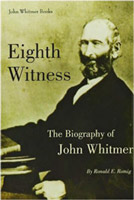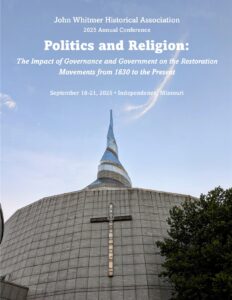Below is an introduction to John Whitmer the man and his life.
By Ron Romig
In 1972, history advocates, initially members of the Reorganized Church of Jesus Christ of Latter Day Saints, (a liberal branch of the Restoration [Mormon] movement- now known as the Community of Christ), selected John Whitmer as namesake for a church oriented historical association. John’s independence, even defiance, of church authorities in 1838, keeping his history free from church control, was seen as representing an early instance of what today may be recognized as academic freedom. Since 1972, John Whitmer Historical Association has grown into an independent scholarly society composed of individuals of various religious faiths who share a lively interest in the history of the Restoration Movement.
John Whitmer was the son of Peter Whitmer, Sr. and Mary (Musselman). He was born 27 August 1802. The family moved to New York from Pennsylvania when John was young. in the late 1820s, the family came in contact with Joseph Smith, founder of the Mormon religious movement. John and the extended Whitmer family assisted Joseph with the preparation and publication of the Book of Mormon. Writing as one of several scribes during the translation, John was selected to be one of the eight witnesses to view the golden plates believed to be the source of the Book of Mormon. His testimony of these events continues to be found in every printing of the work. As a result, John continues to be remembered, by friend and adversary, as one of the founders of Mormonism and witness to the Book of Mormon. He served as the movement’s first historian, 1831-1838, and proved a careful steward of important Mormon documents. His history of the 1830s Church of Christ, called the Book of John Whitmer, provides important insights into the early life of the religion. Regrettably, his writings betray but little of the man himself or his accomplishments, including service as a counselor in the Presidency of the Missouri Church, 1834-1838, and co-founder of Mormondom’s northern Missouri headquarter city, at Far West, Caldwell County.
As a result of internal strife, John was expelled from the church in 1838. The Whitmer clan relocated to Richmond, Missouri. Having served as clerk of the church, John had some of its records in his possession when the church was forced from Missouri by Governor Boggs exterminating order later in the winter of 1838-39. In the aftermath of the expulsion, John Whitmer moved back to Far West and obtained land from departing Saints, acquiring sizable holdings including the temple site. John and Sarah Whitmer, and their five children, built a new frame house at Far West. Both John and Sarah eventually died there. Sarah Maria (Jackson) Whitmer, died first, 15 October 1873. John died on 11 July 1878. His obituary stated, “Mr. Whitmer remained at Far West and has since been a highly respected and law abiding citizen.” He was buried locally, in the Kingston Cemetery, Kingston, Missouri. His family marked his grave with an unusual and impressive white marble gravestone. Despite limited educational economic opportunities and at times personal reluctance, John Whitmer became remarkably well known because of the unique events of Mormonism. Though for forty years John Whitmer stood apart from the Church he helped establish, his long-lived notoriety and success continue to relate to his early involvement in Mormonism. His life was testimony that the essence of the story of Mormonism remained meaningful to him.
Learn more about John Whitmer

Eighth Witness: The Biography of John Whitmer
Ronald E. Romig


